Extending Sino-German Ties
汉语客套话口译
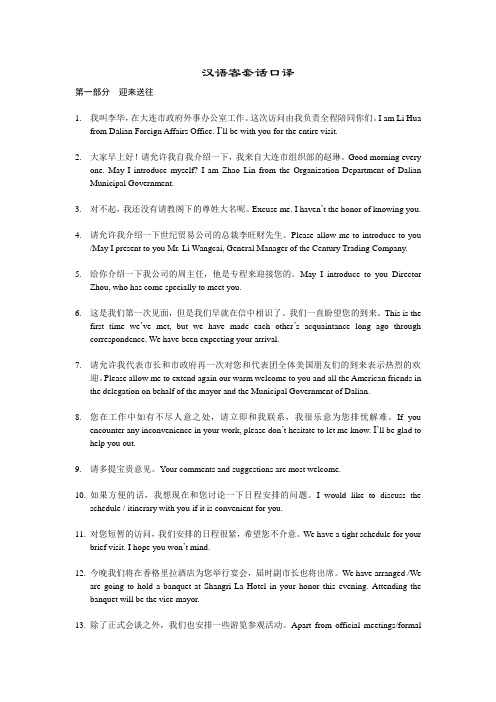
汉语客套话口译第一部分迎来送往1.我叫李华,在大连市政府外事办公室工作。
这次访问由我负责全程陪同你们。
I am Li Huafrom Dalian Foreign Affairs Office. I’ll be with you for the entire visit.2.大家早上好!请允许我自我介绍一下,我来自大连市组织部的赵琳。
Good morning everyone. May I introduce myself? I am Zhao Lin from the Organization Department of Dalian Municipal Government.3.对不起,我还没有请教阁下的尊姓大名呢。
Excuse me. I haven’t the honor of knowing you.4.请允许我介绍一下世纪贸易公司的总裁李旺财先生。
Please allow me to introduce to you/May I present to you Mr. Li Wangcai, General Manager of the Century Trading Company.5.给你介绍一下我公司的周主任,他是专程来迎接您的。
May I introduce to you DirectorZhou, who has come specially to meet you.6.这是我们第一次见面,但是我们早就在信中相识了。
我们一直盼望您的到来。
This is thefirst time we’ve met, but we have made each other’s acquaintance long ago through correspondence. We have been expecting your arrival.7.请允许我代表市长和市政府再一次对您和代表团全体美国朋友们的到来表示热烈的欢迎。
东盟英语
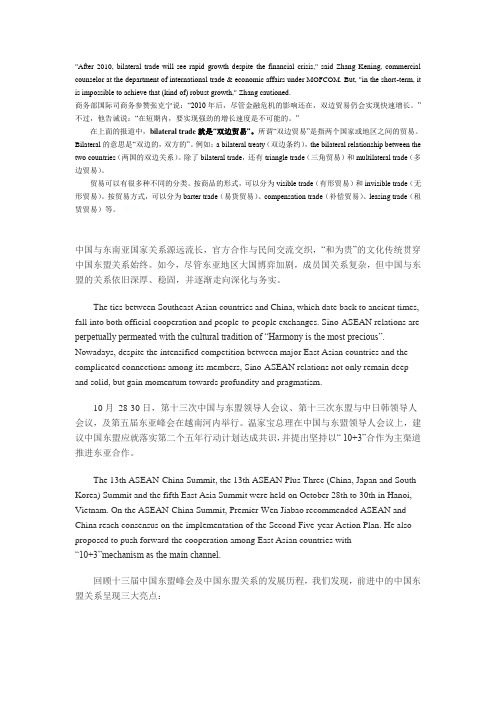
"After 2010, bilateral trade will see rapid growth despite the financial crisis," said Zhang Kening, commercial counselor at the department of international trade & economic affairs under MOFCOM. But, "in the short-term, it is impossible to achieve that (kind of) robust growth," Zhang cautioned.商务部国际司商务参赞张克宁说:“2010年后,尽管金融危机的影响还在,双边贸易仍会实现快速增长。
”不过,他告诫说:“在短期内,要实现强劲的增长速度是不可能的。
”在上面的报道中,bilateral trade就是“双边贸易”。
所谓“双边贸易”是指两个国家或地区之间的贸易。
Bilateral的意思是“双边的,双方的”。
例如:a bilateral treaty(双边条约),the bilateral relationship between the two countries(两国的双边关系)。
除了bilateral trade,还有triangle trade(三角贸易)和multilateral trade(多边贸易)。
贸易可以有很多种不同的分类。
按商品的形式,可以分为visible trade(有形贸易)和invisible trade(无形贸易)。
按贸易方式,可以分为barter trade(易货贸易)、compensation trade(补偿贸易)、leasing trade(租赁贸易)等。
来源中国与东南亚国家关系源远流长,官方合作与民间交流交织,“和为贵”的文化传统贯穿中国东盟关系始终。
大学英语四级131_真题(含答案与解析)-交互
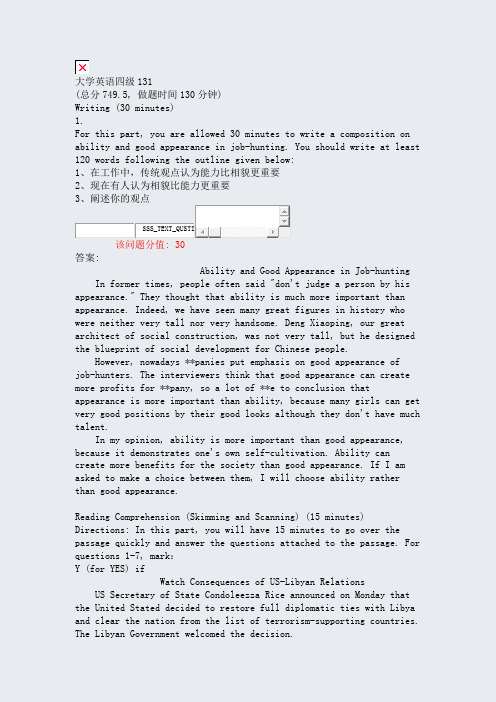
大学英语四级131(总分749.5, 做题时间130分钟)Writing (30 minutes)1.For this part, you are allowed 30 minutes to write a composition on ability and good appearance in job-hunting. You should write at least 120 words following the outline given below:1、在工作中,传统观点认为能力比相貌更重要2、现在有人认为相貌比能力更重要3、阐述你的观点SSS_TEXT_QUSTI该问题分值: 30答案:Ability and Good Appearance in Job-hunting In former times, people often said "don't judge a person by his appearance." They thought that ability is much more important than appearance. Indeed, we have seen many great figures in history who were neither very tall nor very handsome. Deng Xiaoping, our great architect of social construction, was not very tall, but he designed the blueprint of social development for Chinese people.However, nowadays **panies put emphasis on good appearance ofjob-hunters. The interviewers think that good appearance can create more profits for **pany, so a lot of **e to conclusion that appearance is more important than ability, because many girls can get very good positions by their good looks although they don't have much talent.In my opinion, ability is more important than good appearance, because it demonstrates one's own self-cultivation. Ability can create more benefits for the society than good appearance. If I am asked to make a choice between them, I will choose ability rather than good appearance.Reading Comprehension (Skimming and Scanning) (15 minutes) Directions: In this part, you will have 15 minutes to go over the passage quickly and answer the questions attached to the passage. For questions 1-7, mark:Y (for YES) ifWatch Consequences of US-Libyan RelationsUS Secretary of State Condoleezza Rice announced on Monday that the United Stated decided to restore full diplomatic ties with Libya and clear the nation from the list of terrorism-supporting countries. The Libyan Government welcomed the decision.This means that the 25-year-old US-Libyan **es to an end.Interpretation of this varies, the sudden announcement of the rapprochement is closely related to the issue of Iran''s nuclear bidding.Over a long period of time,. Washington called Libya, together with Iran and others, a " rogue nation" , which allegedly supported terrorism, and was one of the seven countries that could be subject to possible US nuclear strikes.The situation altered somewhat since the outbreak of the Iraqi War in 2003. The military forces of the United States and its allies toppled the Saddam Hussein regime with the excuse that Iraq went in for weapons of mass destruction ( WMD) programmes. They did so in hopes of making the regime a public example that would pressure others to give up their alleged WMD bidding.Iran took no heed of this and went on doing what it deemed should be done. Libya, however, was co-operative, abandoning its so-called WMD programmes.For the co-operative attitude on the part of Libya, the United States gave some limited encouragement, restoring diplomatic representatives to the country in 2004.But restoration of full diplomatic relations did not occur because Libya, in the eyes of the United States, remained a "totalitarian" country, running counter to Washington''s push for US-style freedom and democracy, even though Libya''s co-operation in WMD issues was in the United States'' strategic interest.The deadlock over Iran''s nuclear bidding cornered the United States to a dilemma (进退两难的窘境): Military strikes are difficult to carry out right now and diplomatic means are yielding no significant results.It is in this context that US-Libyan ties were put on the agenda. The United States wanted to convey this message: US-Iranian ties could be restored if Iran follows Libya''s example, despite the fact that the United States dislikes the Iranian regime.The message is naturally not only for the ear of Iran and the Democratic People''s Republic of Korea but also for other " rogue countries" —Middle-East nations that are in the throes of transformation and some Latin American countries.The United States, for instance, decided to impose arms embargo on Venezuela almost simultaneously while it announced rapprochement with Libya. The contrast between the punishment and reward helps bring home to other countries the intention that "those who obey survive, those do not perish" in the US international strategy.To what extent this kind of "punishment and rewarding" strategy would impact the Iran and DPRK''s nuclear bidding and those"disobedient" countries, such as Sudan and Venezuela, is worth keeping an eye on.Oil constitutes another important factor behind the rapprochement. As the second-largest oil producing country in Africa and an important nation located in the North, Libya enjoys unique geopolitical and economic value.Currently, the oil-rich Middle East is in chaos and the last thing the Bush administration wants is for the United States to become an "oil hostage" to the Middle East, where the US Government is strenuously pushing for democratic transformation.The situation is compounded by the fact that some Latin American countries are increasingly tilting to the left, threatening to become an unstable energy-resources backyard for the United States.In view of all this, opening up new energy resources-supplying bases becomes a strategic imperative for the United States.More importantly, the United States could use Libya as its military and logistical foothold in the Middle East. So in this sense, both energy-strategy and geopolitical considerations loom large behind the restoration of US-Libyan diplomatic ties.But most importantly, both security interests and oil interests are at the service of a grander strategic goal-overhauling the United States'' African strategy.Since the end of the Cold War in the early 1990s, the USstrategic focus has been shifting from Europe and the Middle East to Central Asia and the Asia-Pacific region, but Africa, a kind of "strategic vacuum area," has gone largely ignored.In the latter half of the Clinton administration, the US Government made diplomatic attempts to strengthen US -African relations, manifested by former US President Bill Clinton''s 12-day Africa tour.But the efforts were largely watered down by a new leader in the White House and the impacts of the terror attacks on September 11 , 2001. As a result, US-African ties have made little progress over the last few years.By contrast, other major world countries have made impressive advances in Africa, taking advantage of the United States'' non-action. Britain, France and Italy, which have traditional ties with African countries, enjoy inherent advantages in advancing relations there. China, traditionally friendly toward Africa, also enjoys a solid foundation in promoting Sino -African ties.The most pressing strategic task for the United States is, therefore, to attach great strategic importance to Africa.It is against this grand strategic backdrop that the restoration of full diplomatic ties with Libya, which still has defective human rights records by US standards, was effected.The United States'' overseas strategy puts strategic interests first, and sidelines other factors like involving values of democracy and human rights till later on.Libya naturally has its own strategic considerations-improving relations with the United States as soon as possible so that its big-country status among African countries and in the Arab world can be restored.Where Africa is going is a question that haunts the **munity. It poses a strategic question African countries themselves must answer as well. With the major world players, political as well as economic, casting their eyes on Africa, African countries face challenges and are also presented with historical opportunities.Will a chain reaction in African-US relations be triggered off by the restoration of US-Libyan diplomatic ties and by the UnitedStates'' increasing strategic input in the continent? This is a subject worth closely watching and following.SSS_SINGLE_SEL2.Libya had ever been regarded as one of the terrorism-supporting countries before.A YB NC NG该问题分值: 7.1答案:A根据文章第一段的clear the nation from the list of terrorism-supporting countries一句透露的信息,美国把利比亚从支持恐怖主义的国家名单中划出,显然言外之意,以前美国曾一度认为其是。
Indochina
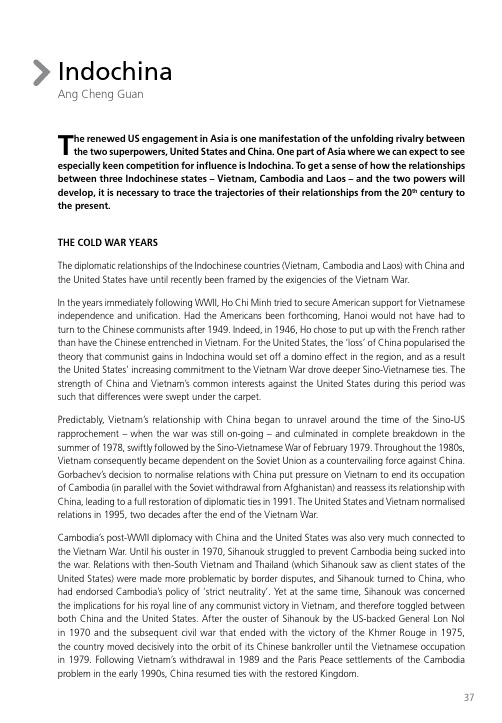
37IndochinaAng Cheng GuanThe renewed US engagement in Asia is one manifestation of the unfolding rivalry between the two superpowers, United States and China. One part of Asia where we can expect to see especially keen competition for influence is Indochina. To get a sense of how the relationships between three Indochinese states – Vietnam, Cambodia and Laos – and the two powers will develop, it is necessary to trace the trajectories of their relationships from the 20th century to the present.The COLd WAr YeArSThe diplomatic relationships of the Indochinese countries (Vietnam, Cambodia and Laos) with China and the United States have until recently been framed by the exigencies of the Vietnam War.In the years immediately following WWII, Ho Chi Minh tried to secure American support for Vietnamese independence and unification. Had the Americans been forthcoming, Hanoi would not have had to turn to the Chinese communists after 1949. Indeed, in 1946, Ho chose to put up with the French rather than have the Chinese entrenched in Vietnam. For the United States, the ‘loss’ of China popularised the theory that communist gains in Indochina would set off a domino effect in the region, and as a result the United States’ increasing commitment to the Vietnam War drove deeper Sino-Vietnamese ties. The strength of China and Vietnam’s common interests against the United States during this period was such that differences were swept under the carpet.Predictably, Vietnam’s relationship with China began to unravel around the time of the Sino-US rapprochement – when the war was still on-going – and culminated in complete breakdown in the summer of 1978, swiftly followed by the Sino-Vietnamese War of February 1979. Throughout the 1980s, Vietnam consequently became dependent on the Soviet Union as a countervailing force against China. Gorbachev’s decision to normalise relations with China put pressure on Vietnam to end its occupation of Cambodia (in parallel with the Soviet withdrawal from Afghanistan) and reassess its relationship with China, leading to a full restoration of diplomatic ties in 1991. The United States and Vietnam normalised relations in 1995, two decades after the end of the Vietnam War.Cambodia’s post-WWII diplomacy with China and the United States was also very much connected to the Vietnam War. Until his ouster in 1970, Sihanouk struggled to prevent Cambodia being sucked into the war. Relations with then-South Vietnam and Thailand (which Sihanouk saw as client states of the United States) were made more problematic by border disputes, and Sihanouk turned to China, who had endorsed Cambodia’s policy of ‘strict neutrality’. Yet at the same time, Sihanouk was concerned the implications for his royal line of any communist victory in Vietnam, and therefore toggled between both China and the United States. After the ouster of Sihanouk by the US-backed General Lon Nol in 1970 and the subsequent civil war that ended with the victory of the Khmer Rouge in 1975, the country moved decisively into the orbit of its Chinese bankroller until the Vietnamese occupation in 1979. Following Vietnam’s withdrawal in 1989 and the Paris Peace settlements of the Cambodia problem in the early 1990s, China resumed ties with the restored Kingdom.Laos is the poorest member of ASEAN, and without much to offer in terms of raw materials, the country is often overlooked by analysts studying the geopolitics of the region. But landlocked Laos is actually of significant strategic importance. In 1960, when Eisenhower briefed the incoming President Kennedy, it was Laos rather than Vietnam that was the focus of his briefing. Although Laos faded into the background after the 1961 Geneva Conference, its pivotal position in the regional Cold War struggle never really diminished. Laos is the only Indochinese country that has maintained unbroken diplomatic ties with the United States from independence to the present, despite the deterioration in relations after the Pathet Lao came into power in 1975. Laos also maintained unbroken diplomatic relations with China, despite siding with Vietnam over its 1979 invasion of Cambodia, resulting in the downgrading of ties to the charge d’affaires level until the settlement of the Cambodia problem.POST-COLd WArVietnam, Cambodia and Laos joined ASEAN after the end of the Cold War in order to become members of a club that would provide them legitimacy and gain them acceptance in the international community. They also hoped to buttress their independence as sovereign states. One common concern was China’s ambitions, although the degree of concern amongst the three states varied.A new phase in the relations between the three Indochina states, the United States and China thus began with the end of the Cold War. It was a slow process of reconciliation for all parties that took up much of the last decade of the 20th century and the first decade of the new century. This was particularly so with the United States, as both American and Indochinese policymakers took a long time to discard the baggage of the Cold War years.ChinaHaving emerged from the Cold War as the three poorest countries in region, the Indochinese nations saw economic benefits from improving relations with China. The Chinese economy was then developing at a rapid pace and showed potential of becoming a global economic power in the future. For the two smaller Indochina countries – Cambodia and Laos – China also served their interests as a bulwark against Thai or Vietnamese hegemony, particularly since historically China had never physically invaded Cambodia or Laos. Beijing was also keen to improve relations with its immediate neighbours, strategically located along its southern border in what some writers have dubbed ‘China’s backyard’. China’s good neighbourliness in Indochina stemmed from its desire for a peaceful and stable external environment to allow it to concentrate on its own economic development; the countries of Indochina, if not properly managed, could disrupt or contain its aspiration to be a global power.Soon after the normalisation of relations in 1991, both Vietnam and China moved to resolve their outstanding bilateral issues, of which there were four. It took nearly ten years before Vietnam and China agreed on the demarcation of their land borders and the Tonkin Gulf in 1999 and 2000 respectively, thus settling two of the four issues. The remaining two - the sovereignty dispute over the Paracel Islands and that of the Spratly Islands persist till today. It is unlikely that Vietnam will be able to regain sovereignty of the Paracels as they are effectively under Chinese control. As for the Spratly dispute, the involvement of other claimants makes it more than a simple bilateral problem.Cambodia took some years to coordinate a coherent foreign policy after the 1993 elections conducted by the United Nations, which saw the formation of an uneasy coalition government led by Sihanouk’s son Norodom Ranariddh and Hun Sen. Since the breakdown of that coalition in 1997, Cambodia has been led by Hun Sen, whom Sihanouk once described as a more astute politician (and an image of himself) than his son Ranariddh. The Chinese had been unwavering in their support of Sihanouk and by extension his FUNCINPEC Party (led by Ranariddh), while Hun Sen was seen as a Vietnam protégé.38However, after 1997, Hun Sen began taking proactive steps to endear himself to China, most prominently when he cut links with T aiwan and paid a visit to Beijing to pay his respects. He also accepted China’s help in building the National Assembly building after the 1998 elections which he won with a simple majority and thereafter became the sole prime minister. Like Sihanouk, Hun Sen has continued to maintain good relations with Beijing (despite its previous support of the Khmer Rouge). The Chinese have apparently now concluded that they prefer dealing with Hun Sen to Ranariddh, and China is now Cambodia’s top aid donor and foreign investor. In the aftermath of the 45th ASEAN Ministerial Meeting (AMM) in Phnom Penh in July this year which failed to produce a joint communique – the first time it happened in ASEAN’s history – the closeness of Sino-Cambodia relations has been the subject of intense regional scrutiny.As for Laos, the successful settlement of the Sino-L aos frontier demarcation in 1992 has seen the development of a thriving cross-border trade. China has been actively competing with Vietnam for the political allegiance of L aos, and in 2010, China supplanted Thailand as the largest foreign investor in Laos. According to Dominique Van der Borght of Oxfam Belgium, Chinese projects in Laos are on a large scale and have led to concerns in Vientiane that China, Vietnam and Laos are competing to use Laos as ‘an extension of their territory.’The China ThreatSince the 1990s, there has been an uneasiness among Southeast Asian countries that China’s rise might constitute a threat to the stability of South East Asia. Seeking to mitigate its neighbours’ concerns, Beijing adopted a diplomatic charm offensive, emphasising that economic interdependence amongst the ASEAN countries and China was beneficial for all. The most notable examples are China’s decision not to devalue its currency during the Asian Financial Crisis (1997), and the 2001 proposal to establish an ASEAN-China Free Trade Area (ACFTA) which came into effect in January 2010. The most recent is an in-principle agreement to create an Asian Free Trade Area. Yet China’s efforts to co-opt its neighbours are not confined to economics. In 2003, China signed the ASEAN Treaty of Amity and Cooperation (TAC), which commits Beijing to ASEAN norms in inter-state relations – mutual respect, non-interference in others’ internal affairs, settlement of disputes in a peaceful manner, and the renunciation of the use of force. However, despite Chinese assurances, regional neighbours are yet to be fully persuaded that China will never seek hegemony. Such reservations aside, in the two decades after the end of the Cold War it remained essential for the Indochinese states to maintain good relations with their neighbour – a burgeoning economic (and in time potential military) giant – especially when there was no other countervailing power that they could count on.United StatesCompared to Beijing, Washington was slow to improve relations with the three Indochina countries. It was not that Indochina was reluctant to win American favour – in the period after the end of the Cold War, the United States was universally recognised as the most powerful country in the world – but rather that the importance of Southeast Asia waned considerably in Washington following the Vietnam War. With the end of the Cold War, Southeast Asia also had to compete with a new Europe and events in the Middle East for Washington’s attention. Washington did re-orient its attention towards Southeast Asia after 9-11, but its interest was largely confined to the issue of terrorism and thus had little impact on its relations with the Indochinese states, as Vietnam, Cambodia and Laos do not have substantial Muslim communities.The top priority for Indochina and China since the end of the Cold War has been economic growth, jobs and trade. The United States expected political and economic reforms as prerequisites for closer bilateral relations, whereas China was less constrained by such concerns, if at all. The formation of the ASEAN Regional Forum in 1994 was a tool not simply to tie an emerging China to a multilateral network, but to keep the US engaged in the region as well. Indeed, China’s diplomatic successes following the end of the Cold War were to a large extent enabled by the United States’ apparent lack of interest in the region as a whole.39The main impediments to enhancing Indochina-US relations were the baggage of the Vietnam War and America’s focus on human rights and corruption in those countries. Although diplomatic relations between the US and Cambodia were established after the UN-sponsored election in 1993, relations were cool as a consequence of Hun Sen’s seizure of power in 1997 and his subsequent poor human rights record. Relations only improved from around 2006-07 when US officials began to become cognisant of the increasingly close ties between Phnom Penh and Beijing. In early 2007, Washington lifted a decade-old ban on direct aid to Cambodia, which observers viewed as a harbinger of better US-Cambodia relations. In 2010, US Secretary of State Hillary Clinton used the occasion of her visit to Phnom Penh to urge Cambodians to diversify their international relationships and not to be over-dependent on China, by which time the Chinese had already established a significant presence in the country.In the case of Laos, although diplomatic relations with the US were never broken, the relationship was plagued by the legacies of the Vietnam War, including concerns about prisoners of war and personnel missing in action, unexploded munitions, the poor treatment of the Hmong by the Lao government, and the Laotian suspicion that long after the Vietnam War the CIA continued to be in league with the Hmong leader Vang Pao to undermine the Lao regime. Laos did not gain Normal Trade Relations (NTR) status with the United States until 2004, a prerequisite under US law for any bilateral trade agreement. The US arrest of Vang Pao in 2007 apparently gave the relationship a fillip, and his death in 2011 finally closed this chapter in US-Lao relations even if not fully. Hillary Clinton visited Vientiane in July this year, the first Secretary of State to do so in almost five decades.Vietnam normalised relations with the US in 1995 (just before its admission into ASEAN) but was only given NTR status in 2001. Like Laos, the legacies of the Vietnam War, notably the POW/MIA and Agent Orange issues impeded the development of better bilateral relations, as conservative elements in the Vietnamese leadership remained suspicious of the United States. Since President Clinton visited Vietnam in 2000 – the first US president to do so – relations have been improving, despite occasional hiccups over trade and human rights issues.Across the post-Cold War era and until very recently, US relations with the Indochinese states were very much driven by Washington’s broader interest in and engagement with ASEAN. For example, the US normalised relations with Vietnam on 11 July 1995, just before Vietnam became a full-fledged ASEAN member in the same month, but bilateral relations were slow to develop thereafter. After years of debate, Laos was finally granted normal trade status in 2004, the year Vientiane assumed the rotating ASEAN chair.A NeW TUrN IN INdOChINA-US-ChINA reLATIONS?In January 2012, President Obama announced that the US intends to strengthen its presence in Asia, notwithstanding the largest cuts to the United States’ defence budget since the end of the Cold War. The announcement also marks the beginning of a re-invigoration of US-Southeast Asia relations. Washington’s new-found concern about a rising China at long last coincides with the long-running exhortation of the Southeast Asian countries for the US to be more engaged in the region in order to balance China.It is, however, too soon to tell how the triangular relationships between the Indochinese states, the US, and China, will develop. As noted above, Hillary Clinton visited Laos in July this year after a five-decade hiatus, which is a good start. US-Vietnam relations are expected to continue to improve. Of all the Southeast Asian capitals, Hanoi is most enthusiastic about the US presence in the region; certainly, of the three Indochinese states, it is Vietnam that has the most problematic relations with China, and looks mainly - although not exclusively- to the US as a countervailing force against Beijing. As for Cambodia, their exceptionally close ties with China are no secret. Lee Kuan Yew was reported to have complained that China’s close ties with the country (as well as Laos) meant that within hours, everything that is discussed in ASEAN meetings is known in Beijing. What is perhaps unexpected is Phnom Penh’s failure, in its capacity as40ASEAN Chair of the 45th ASEAN Ministerial Meeting (AMM) in July 2012, to produce a joint-communique, and soon after it was reported that China had pledged more than $500 million in soft loans and grants to Cambodia, which was interpreted by many as a ‘reward’ to Phnom Penh for putting China’s interests on the issue of the South China Sea dispute ahead of the wider ASEAN community. Cambodia will need to recover the trust of its ASEAN colleagues, as well as better balance its relationship with China and its responsibilities as a member of ASEAN. The United States, too, will have to work much faster to improve relations with Cambodia and Laos if it hopes to steer Phnom Penh and Vientiane away from their over-reliance on China.CONCLUSIONVietnam, Cambodia and L aos recognise that they each have to live with a neighbour that is generally projected to be the world’s largest economic power sometime in the coming decade, with the implication that the 21st century will be ‘China’s century’. Each recognises the reality distilled by Lee Kuan Yew when he said that ‘your neighbours are not your best friend, wherever you are’, and that diplomacy is easier with ‘those who are farther afield with whom we can talk objectively’.History has shown that none of the Indochinese countries willingly choose to be under the tutelage of China. Vietnam, Laos and even Cambodia want the US to be engaged in the region. They all want to have good relations with Washington. But the United States’ economic and financial difficulty is troubling, and there is uncertainty about America’s long-term commitment to the region, despite the Obama administration’s strategic pivot to Asia. In Indochina, there has been a revival of the debate about American decline which receded from prominence in the 1990s after the end of the Cold War appeared to refute Paul Kennedy’s 1989 thesis in The Rise and Decline of Great Powers. On that broader debate, the jury is still out, but neither Vietnam, Cambodia nor Laos want to be caught flat-footed. Collectively, they all seek a US presence in the region as a hedge against Chinese dominance, but fear that were such a presence to become confrontational it would oblige them to choose between Washington and Beijing, the very choice that to date each has sought to avoid. ■41。
英美报刊选读chapter_2_News_Headlines

Grammatical features---- Predicate
(2) Participial phrase as predicate Identities of Hijack suspects released U.S. Attacked: Hijacked jets destroy twin towers and hit pentagon in day of terror Fed expected to make a half-point cut in rates US weather forecasters caught out by storm Top Pakistan judge dismissed after refusing to take oath
Grammatical features---- Predicate
(1) Adjective as predicate US carmaker ready to cut output Buenos Aires “close” to deal on fresh IMF loan EU and China closer to deal on Beijing’s WTO entry
The pun in this case is in the words burning
questions. The questions are about fires, hence burning questions, but burning question is another way of saying an important or urgent question. The term gender has to do with male and female; and the newspaper article in question deals with the return of tension in the working relationships of men and women in London post offices. The headline is a pun on the instruction Return to sender, which is stamped on letters that cannot be delivered and must be sent back to the people who wrote them.
中美关系专业词汇

中美关系新名词Chimerica1.政治方面:state visit国事访问Sino-US ties/China-US relations 中美关系bilateral tie 双边关系bilateral cooperation 双边合作direct contact 直接接触joint statement 联合声明in the spirit of the joint statement 本着联合声明的精神China-US joint communiqué中美联合公报top leaders 最高领导人national interests 国家利益core interests 核心利益common interests of the two countries 两国共同利益personality of the individual leaders 领导人的个人魅力frequent meetings 频繁会晤"conflict-dominant" relationship “冲突主导”的关系start a new era in US-China relations 开创中美关系的新时代the normalization of US-China relations 中美关系正常化permanent consultative institutions 永久磋商机制constructive strategic partnership 建设性战略伙伴关系overall strategic partnership 全面战略伙伴关系rapprochement 恢复邦交Ping Pong diplomacy 乒乓外交high-level cooperation 高层协作Strategic and Economic Dialogue 战略经济对话establish diplomatic ties 建立邦交highly confidential visit 秘密访问zero-sum game零和博弈mutual trust 相互信任common prosperity 共同繁荣peaceful coexistence 和平共处the situation on the Korean Peninsula 朝鲜半岛局势resumption of Six-Party Talks 重启六方会谈high-level visit 高层访问maintain a low profile 保持低姿态China will never seek hegemony. 中国永远不会称霸。
中美关系词汇集锦
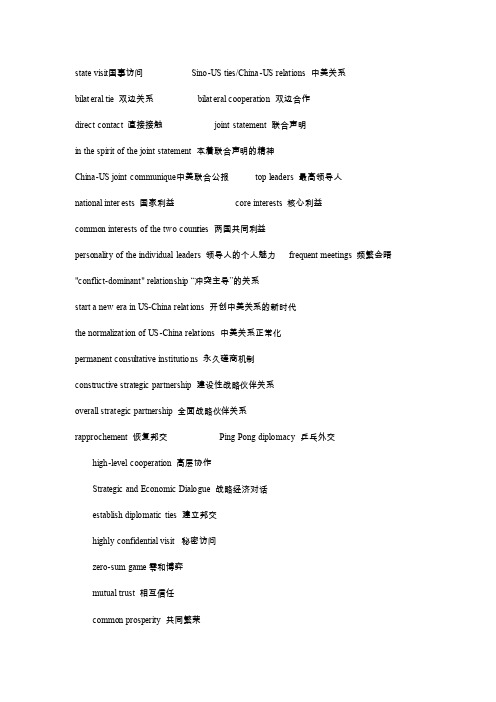
statevisit国事访问Sino-US ties/China-US relati ons 中美关系bilate ral tie 双边关系bilate ral cooper ation双边合作direct contac t 直接接触jointstatem ent 联合声明in the spirit of the jointstatem ent 本着联合声明的精神China-US jointcommun ique中美联合公报top leader s 最高领导人nation al intere sts 国家利益core intere sts 核心利益common intere sts of the two countr ies 两国共同利益person ality of the indivi dualleader s 领导人的个人魅力freque nt meetin gs 频繁会晤"confli ct-domina nt" relati onshi p“冲突主导”的关系starta new era in US-Chinarelati ons 开创中美关系的新时代the normal izati on of US-Chinarelati ons 中美关系正常化perman ent consul tativ e instit ution s 永久磋商机制constr uctiv e strate gic partne rship建设性战略伙伴关系overal l strate gic partne rship全面战略伙伴关系rappro cheme nt 恢复邦交Ping Pong diplom acy 乒乓外交high-levelcooper ation高层协作Strate gic and Econom ic Dialog ue 战略经济对话establ ish diplom aticties 建立邦交highly confid entia l visit秘密访问zero-sum game零和博弈mutual trust相互信任common prospe rity共同繁荣peacef ul coexis tence和平共处the situat ion on the Korean Penins ula 朝鲜半岛局势resump tionof Six-PartyTalks重启六方会谈high-levelvisit高层访问mainta in a low profil e 保持低姿态Chinawill neverseek hegemo ny. 中国永远不会称霸。
科技三项费用管理办法 - sino-germanecoparkgovcn

第十九条 科三费采取分批拨付的方式。在《合同》签订后,区财政局先期拨付合同资金的80%,其余20%资金暂由 项目承担单位垫支,待项目验收合格后拨付。
第五章 科三费的监督与验收
第二十一条 凡列入区科技发展计划的项目,项目承担单位必须在每年的6月和12月分别向区科技部门和财政部门 报送资金使用明细表、年度项目实施情况报告、年度专项经济分析报告、项目进度和阶段成果表。
第二十二条 凡列入区科技发展计划的项目,项目承担单位在项目完成后应当按照项目合同要求提出验收申请后, 由区科技部门会同财政部门组织中介机构对项目承担单位科三费使用情况进行审计,并组织专家组对 项目进行验收,条件成熟的项目可以申请科技成果鉴定。
第十三条 科三费实行项目补助、贷款贴息和配套资金三种支持方式,根据科技项目类型不同,给予不同额度和 方式的资金支持。支持方式和额度将根据每年科技计划的具体情况和申报项目的特点而确定。
(一)项目补助:对项目单位以自有资金为主投资的项目给予定额、定项补助的支持方式,支持额度原 则上不超过项目总投资的30%。
(三)社会发展和医疗卫生。主要支持人口与健康、环境保护、城乡建设、劳动安全、公共安全、减灾防 灾等领域的社会科技活动,促进可持续发展。
(四)国际科技合作。主要资助与国外合作开展的技术研究开发、吸收和获取国外创新成果、引进国外 先进技术和海外优秀创新人才、推动技术出口等国际科技合作项目与交流活动。
(五)支持国家、省、市下达的且明确要求地方财政匹配的科技计划项目。
第五条 科三费由区科技部门、财政部门共同管理,按照职能各司其职,并接受区审计部门的审计监督。
中德职业教育联盟-Sino-GermanDialogueForum
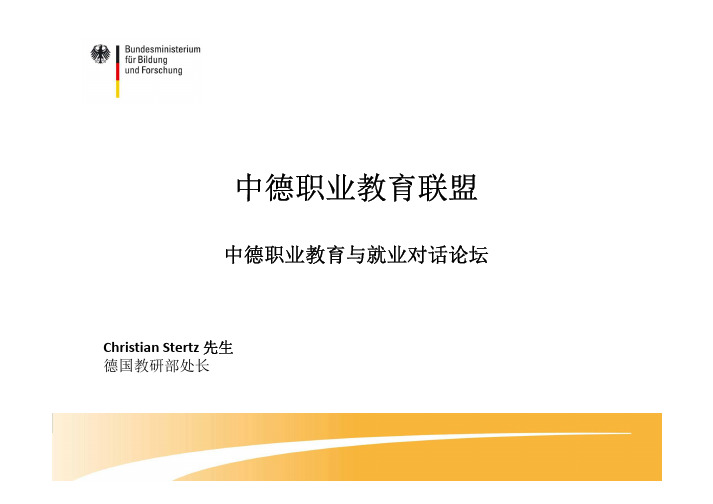
合作目标: • 在伙伴国支持职业教育改革 • 目标为青年失业率最小化和人力资源开发(以欧盟地区为主) • 关注地方经济和德国企业利益
5
德国教研部职业领域的国际合作
职业教育双边工作组的活动:
对合作伙伴的协调、共同合作的项目进行定期会议 ,如发展: • 职业教育标准:职业类型和课程框架 • 培训人员进修课程 • 公司内部培训中心 • 合作管理的途径:职业教育与培训机构 、审计委员会及其他相关委员
究、经济、金融等合作
中德职教联盟
目标 • 使政治和经济之利益相关者合作。 • 使职业教育的政策深入交流,使其研究和发展为两国带来利益。 • 在中国建立职业教育合作中心。 • 在中国支持职业训练。
中德职教联盟
职业教育的合作中心
重庆 自2011年以来,首个中心关注于学员资格在汽车和IT领域 此中心由重庆师范大学和德国手工业技能发展中心共同领导建立
会
6
德国教研部职业领域的国际合作
支持项目和研究 出口职业教育 • 支持职业教育和培训的德国供应商在快速成长的国际市场 • 给德国教育机构的合作项目提供长达三年的研究和开发支持 • 支持创新的方法和新的商业模式的发展
iMOVE (International Marketing of Vocational
青岛
自2013年11月,为青岛市教育局主办 重点为环境技术的职业教育
14
中德职教联盟
VETnet 项目 • 开始于2013年10月,德国工商总会领导
11个德国工商大会
目标: – 职教联盟的框架下所有利益相关方之直接对口 (德国和中国双方) – 执教联盟为协调员与发起者之培训 – 建立保证质量结构的顾问 – 审查和认证 – 中国负责人:Britta Buschfeld女士,AHK上海
Review on Sino-German Cooperation Projects on Sustainable Forest Management
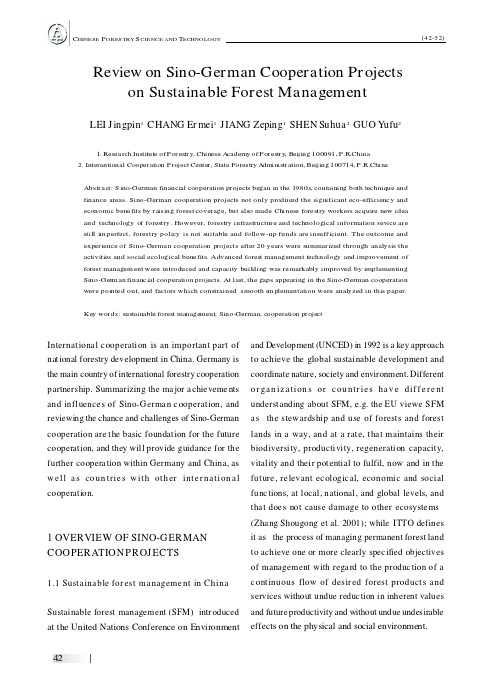
C HINE SE F O RES TRY S CIE NCE AND TE CHNO LO GYReview on Sino-German Cooperation Pr ojects on Sustainable Forest Management LEI Jingpin1CHANG Er mei1JIANG Zeping1SHEN Suhua2GUO Y ufu21.Resea rch Institute of F or estr y,Chinese A cademy of F or estr y,Beijing100091,P.R.China2.Interantional Cooper ation P roject Center,State Forestry A dministr ation,Beijing100714,P.R.ChinaAbstr a ct:S ino-German financial cooperation pr ojects began in the1980s,containing both technique and finance areas.Sino-German cooperation projects not only produced the significant eco-efficienc y and economic bene fits by r aising forest coverage,but also made Chinese fore stry workers acquire new idea and technology of forestry.However,forestry infrastructur e and technological information sevice ar e still im perfect,forestry policy is not suitable and follow-up funds are insuff icient.The outcome and exper ience of Sino-Germa n cooperation projects after20years were summar ized through analysis the activities and social ecological bene fits.Advanced forest management technology and improvement of forest managem ent were introduced and capacity building was re markably improved by implementing Sino-Germ an financ ial cooperation projects.At last,the gaps appearing in the Sino-German cooperation wer e pointe d out,and factors which constrained smooth im plementation were analyzed in this paper.Key wor ds:sustainable forest management,Sino-German,cooperation pr ojectInternationa l c ooperation is an important part of national forestry development in China.Germany is the main country of international forestry cooperation partnership.Summarizing the ma jor a chie veme nts and influence s of Sino-G erma n c ooperation,and reviewing the chance and challenges of Sino-German cooperation are the basic foundation for the future cooperation,and they will provide guidance for the further coopera tion within Germany and China,as w e ll a s co un trie s w ith oth er inte r na tion a l cooperation.1OVERVIEW OF SINO-GERMAN COOPERATIONPROJECTS1.1Susta ina ble for est ma nageme nt in ChinaSustainable forest management(SFM)intr oduced U N f and Development(UNCED)in1992is a key approach to achieve the global sustainable development and coordinate nature,society and environment.Different o r ga n iz a tion s or c ou ntr ie s ha v e dif f e r e nt understanding about SFM,e.g.the EU viewe SFM a s“the stew ardship and use of forests and forest lands in a way,and at a rate,tha t maintains their biodiversity,productivity,regeneration capacity, vitality and their potential to fulfil,now and in the future,re levant ec ologic al,economic and social func tions,at local,national,and global levels,and tha t doe s not cause damage to other ecosyste ms”(Zha ng Shougong et al.2001);while ITTO defines it as“the process of managing permanent forest land to achieve one or more clearly spec ified objectives of management with rega rd to the produc tion of a c ontinuous flow of desir ed forest products a nd services without undue reduc tion in inherent values and future productivity and without undue undesirable ff y”(42-52)42at the nited ations Con erence on Environment e ects on the ph sical and social environment.V ol 9N o 420103Curr ently the FAO de fines SFM a s a behaviour encompassing the administrative,ec onomic,legal,social,te chnica l and scientific aspe cts,involving both natural forests and plantations and implying various degrees of deliberate human interve ntion to safeguard and mainta in forest ecosystem and its functions.China has been studying and carrying out campaigns on SFM for a long time and such efforts have been attached with importa nce and supports by the State Forestry Administration (SFA)of China (Lei Jingpin et al.2004).On the National Forestry DG (director-ge ne ra l)Me eting in 2007,Mr.Jia Zhiba ng,administrator of SFA,pointed out that SFM was a function of China forestry and affirmed that SFM would be a key topic for China forestry for a very long time.Being a crucial part of China ’s international forestry coopera tion,the Sino-German cooperation helps introduce and absorb the advanced experience on forest management from Germany and find out a SFM de velopment mode in the Chinese context,which have laid a solid foundation for the sustainable forest development in China.1.2Reviews on histor y of Sino-G er ma n cooper ationTo e xte nd internationa l excha nge s,stre ngthe n national power and boost the economic de velopment are importa nt instrume nts a nd basic experience adopted by all countries during their development (ICD 2005).All countries are seeking new modes to develope forestry,while undoubtedly the sustainable de velopme nt is a n inevita ble choic e to us.I n particular,China is fac ed with freque nt natural disaste rs an d inc re a singly comple x ta sks on improving the ecological environment,so it has been x y z the sustaina ble forest development and find out China ’s own mode of sustainable development in the course of international cooperation.The Sino-German cooperation on forestry began in the 1980s,mainly covering technical a nd financial areas.The technical cooperation began in 1983,while the financial cooperation began in 1993.So far there have been 51economic and te chnical cooperation projects,involving a total grant sum of 80million yuan.The cooperation between the Chinese and G e rm a n go ve rn me nts on sus tain ab le fo re st developme nt began in the early 21st century.Under a decade development,8proje cts on SFM have been implemented in 20provinces,autonomous regions or municipa litie s of China under concerted efforts of the two governments with a total investment of 502million yua n.The Sino-German Coopera tion Proje cts on SFM aim at introducing the concepts a nd technology of German close-to-nature for est mana ge ment,improving the capacity and le vel of forest management,realizing the multiple benefits and functions of forests and working out the mode and experienc e of forest management to set exa mples.The Sino-German Cooperation Project on SFM is significantly important for both the promotion of SFM in China and the forest management itself.2SINO-GERMAN COOPERATIONPROJECTS AND ACTIVITIES ON SFM2.1Pr ojects on SFMThe Sino-German cooperations on SFM began in the 21st century,most of which are financial cooperation projects,accounting for 75.0%of the tota l projects a nd 82.8%of the grant sum,a nd small parts are j M f f 4e tensivel recogni ed as a right direction to achievetechnical cooperative pro ects.ost o the inancialC HINE SE F O RES TRY S CIE NCE AND TE CHNO LO GYcooperation projects refer to those projects on SFM converted from the previously fina ncial projects on af fore sta tion.The oldest Sino-German financia l coope ration projec t wa s imple mented in Sic huan with a dura tion of10ye ars,which was completed in2008.Such projects began to study on SFM on the ba sis of the previous affore station proje cts and subsequently more and more projects signed by the two governments as financial cooperation and loan projects mainly aiming at afforestation were shifted to forest management for the sustainable development of local forests(Table1).Implementing Grant Project ProjectFeatu res No.Project title Donor agency(106yuan)implementing durationagencySino-German Financial SFA andCooperation Framework provincial1Project on Sustainable BMZ KfW 3.84offices for the2009-2011FrameworkForest Management in Sino-Germanproject South China projects cooperativeSino-German TechnicalCooperation ProjectBMZ KfW38.40SFA2008-2012Policy2(Sus tainable Forest stu dy Management Policies andModes)3Cooperation Project onBMZ KfW81.34Department of2007-2017SFM Sustainable Fo rest Guizhou project Management in Guizhou Province4Cooperation Project onBMZ KfW126.00Department of1998-2008SFM Sustainable Fo rest Sichuan project Management in Sichuan ProvinceSino-German FinancialForestry5Cooperation Project on BMZ KfW-Department of-SFM Sustainable Forest(Net lend ing)Hubei Province project Management in Hubei(III)Sino-German FinancialForestry Afforestation6Cooperation Project on BMZ KfW96.00Department of2002-2010and p overty Afforestation and Poverty Anhui Province alleviation Alleviation in Anhui(II)Sino-German FinancialCooperation Project on Forestry SFM and7Sustainable Fo rest BMZ KfW108.00Department of2009-2015poverty Management and Poverty Anhui Province alleviation Alleviation in Anhui(III)Cooperation Umbrella8Program for Sustainable BMZ GTZ48.00SF A2004-2007Umbrella Forest Developmen t inprogram West ChinaT5Tab le1.Sino-German financial cooperative p rojects on su stainable f orest man agement44otal02.00V ol 9N o 4201052.2Activities on SFMThe activities on SFM jointly held by China and Germany are compose d of projec t ac tivities and training workshops on SFM based on the former.Par ticipa nts to the pro je c t-re la te d me etings introduced the prac tices and e xperiences on SFM in their respective c ountries and province s and3MAJOR ACHIEVEMENT S AND INFLUENCE S OF SINO-GERMAN COOPERATION3.1O bvious ecologica l a nd socia l benefits The impleme ntation of projects has significantly improved both the forest c overage a nd the forest quality of projec t a reas a nd enhanc ed the forest function in conserving soil and water (Chen Quanhui )T f f and the e nvironment quality has dr amatically improved.The projec ts also help boost the rural economy and remarkably improve the rural people ’s livelihood.T he expe cte d goals of e cologica l,economic and social benefits have been attained (Jens Mackensen et al.2008).3.2Attr a ction of ca pita l a nd introduction of advan ced ma na gem ent mea sur esT S G f proposed a number of c onstructive suggestions on the applica tion of SFM in China.The tra ining wor kshops ha ve inc re ase d w ide te c hnician s ’awarene ss and understanding of the concept,goal and purpose s as well as the technica l principles of SFM,w hich has la id a solid foundation f or the division of field surveys on SFM a nd the development of community forest management plans (Table 2).Table 2.Sino-German coop eration activities on sust ainable forest managementNo.ActivitySponsorTime Location 1Sino-German Dialogue on Sustainable SF A and GTZ China Oct.25-27,Beijing,China Fo restry20052BMZ,GTZ and SFA 2006SFMGermany 3Training on SFM by Afforestation GTZ in ChongqingAug.14-16,Chongqing,Project in Chongqing2007China 4International Conference on SFM Anhui,China of Anhui Pro vince and KfW 20085Symposium on SFM Consensus Government of Germany and June 24-26,Beijing,China SFA20086Sino-German SFM Research,Training Forestry Bureau of Hubei June,2009Hubei,China and Serv ice (Mobile)Province7Training Workshop on Forest SFA,Chinese Academy of Nov.23-27,Fujian,ChinaCertificationForestry (CAF)and Forestry 2009Department of Fujian Province 8Sino-German High-ranking Expert BMBF and CAF Nov.24-26,Beijing,China Symposium on Sustainable Forestry 20099Sino-German Dialogue MeetingBMZ,KfW and SF AMay 17-21,Berlin,Germany(SFM,An Opportunity for Co-existence 2010of Economy and Ecology)42004.he area o wildli e habitats has increa sedhe ino-erman cooperation attracted grants romC HINE SE F O RES TRY S CIE NCE AND TE CHNO LO GY6Germany for sustainable forestry development.The project provided certain vehicles,office fac ilities and training facilities,which have fully improve the working conditions for the project management and te chnic al staf f.In ter ms of orga niza tion a nd management,the afforestation project adopted the participa tory land use and planning technology and interest mechanism to regulate the implementation,with rewards and punishments strictly exe cuted,a double-wir e responsibility syste m was set up and the management me asure s were forms of “three c en tr aliz ations ”,“thre e co ntra cts ”a nd “one responsibility ”.A separate account was opened for the projec t funding to ensure the money will be spe nt exclusively for the project.Reimbursement and auditing are implemente d and the money is direc tly paid to fa rmers through IC car ds.The scie ntific monitoring eva luation te chnology has c on tin uou sly upgr a de d the le ve l of p roj ec t management.3.3Intr oduction of advanced conceptsA n open a nd pa rticipatory wa y w as applied to m obiliz e loc a l f a r me rs d ur ing the p r oje c t impleme ntation (Qu Guilin et al.2003).Concepts of community and community forest developme nt,a ttention to the disadva ntage d,susta ina bility,biological diversity,plantation of mixed forests and whole-process management were introduce d and re late d guidelines were fully impleme nted in the whole course of the projec t.3.4I ntr oduction of a dva nced for est ma na geme nt technology a nd im pr oveme nt of for est mana gementT f x f pr omoted a nd dif fe re nt mixtu re s of c onife r-broa dleaf,broadleaf-broadleaf,original specie s-newly-planted species,tree-bush,a nd forest-gra ss were implemented (Pan Tianming 2007).Moreover,the p roje ct a lso imple men ted e nc losur e an d afforestation and rehabilitate d the ecology in both hilly a nd gully a reas.Natur al regenera tion with timely tending to forests of priorities,manageme nt of uneven-aged forests and development of long-term forest management plans were adopted to unify the program mea sures with biological measure s.Sufficient fund was allocated to improve the tending tec hnology for young tr ee s a nd un der -store y regene rations,produc e poisonous sticks to contr ol popla r longhorne d bee tle s,produce Bea uver ia bassia na to control pine caterpillars,hang nests to attra ct beneficial birds and develop other artificial assistance measures.The project cultivated healthy spe cie s with exuberant vitality and re silie nc e to re sist invasive pe sts a nd dise ases (Che ng Pe ng 2008)to control forest pests and diseases.The use of water-retaining agents significantly ameliorated soil,increased the survival rate of seedlings beca use of moisture conservation and resistance to drought and accelerated the growth of seedlings and young trees (Sun Shujuan 2003).Contr ols of specie s and provenance,strong seedlings,sites a nd density were fully conduc te d to e nsure the qua lity of plante d forests (Zhang Liangshi 2004).Afforestation and la nd pre pa ration technology tha t c an reduce and pre vent soil a nd w ater erosion,tec hnology of dyna mic monitoring on the projec t progress and quality based on PC database and GIS and random sampling technology were applied.3.5Rema r kable impr ovement of ca pacity buildingf q y x 4he pla nta tion o large -are a mi e d ore sts w asA la rg e n umbe r o ua lit a nd e pe r ie nc e dV ol 9N o 42010professional talents good a t administration were c ultiva te d thr ough the projec t.The vigor ous development of specia l forest fa rme r households helps them become an important driving force for Chinese forestry deve lopment.3.6Extensive exemplar y a nd r a diative demonstr ation of pr ojectThe oper ation mode and management expe rience of the Sin o-G er ma n c oope r ation p roje cts o n su sta ina bl e fo re s t de v e lopm en t h a ve b e e n suc cessfully extended to ma ny interna tional and national projec ts in a radiative way,e.g.the project on conve rting fa rmlands to fore sts,the proje ct on natural forest protection and Sino-EU project on natural ly,the applied participatory method paid attention to the decisions and choices of people in the projec t a rea s fr om the pr ojec t preparation and the development and implementation of plans to the project implementation.Mixed forests we re pla nted by sub-compa rtment de sign a nd operation in a close-to-nature way,which controls logging f rom both a re a a nd cutting quota a nd re quir es tha t the mixe d fore sts at le ast should account for a half in the ne w afforestation projects with combina tion of the biological prevention and control of forest pests and the density of plante d fore sts throughout the whole project proc ess.The projec t financial mana gement system is composed o f se pa r a te a c c o un t f o r r e i mb u r se m e n t,re imburse me nt a fter proje ct v er if ica tion a nd a cc e pta nc e,pu blic bidding for pr ocu re ment,auditing and supervision.The project invited public biddings for se edlings,whic h has improved the se edling quality and inc re ased the survival rate of ff x y applied by forest authorities at various le vels.The contract-based management ha s clearly defined the rights and obligations of all project participants and pre se t the pr oje ct implementation pr oce dures,criteria,contents and outcomes.The manage ment f ra me w o rk c ove r ing fin a nc ia l a gr e em e nts,responsibility system,contrac ts on forest plantation and seedling cultivation,te sting contracts,in-kind ma ter ia ls a n d fa c ilitie s p ur ch ase c ontr a cts,re gula tions a nd te chnica l guidelines ha s be e n incre asingly improved a s the implementa tion of pr ojec ts.The mo de of a rc hive a nd da ta ba se management is also borrowe d by othe r projects (Table 3).4GAPS APPEARING IN SINO-GERMAN COOPERATIONThe Sino-Ger ma n projec t on sustainable forest development has been implemented for more tha n tw o de cades.The impleme ntation helps Chinese fo re st sec tor yie ld a num ber of fru its in the international cooperation.However,some problems still exist in China.1)The infrastructure,sc ience and technology and information service for forest de velopment still fall behind.The out-date d forest infrastructure including forest r oa ds a nd basic operation equipme nts ha s brought various challenges to the implementa tion of introduced concepts and affected the application of introduced te chnology.Mea nwhile,some for est farms and forestry bureaus lack basic data.Even if some loc a litie s o wn the ba sic da ta ,but the incomplete or invalid data for the new technology 47a orestation and has been e tensivel adopted andha v e a lso b r oug ht a dv e r se imp ac ts on theC HINE SE F O RES TRY S CIE NCE AND TE CHNO LO GYimple mentation of introduced te chnology.For example,during the introduction of close-to-nature forest manageme nt technology by the Sino-German Tec hnic al Cooper ation Umbr ella Progra m for Sustainable Forest Development in West China,the expe riment in Xiaolongshan Forestry Bureau was challe nged by the insufficient basic data of fore st compartments and sub-compartments.There fore, large inputs inc luding both human resourc es and materials were made to survey and collect basic data, which brought negative impacts on the experiment and demonstration.2)A certain process is needed to understand the new technology and concepts.People think that the close-to-nature management conce pt involves comple x pr oce dure s,which le a ds to the inappr opria te imple mentation in pr actice.The close-to-nature management requires setting up an objective firstly and it is obviously more complicated than the original clear cutting and selective c utting.Moreover,thef j f r e la te d kn ow le d ge a nd kn ow-ho w,f o r e st manageme nt tec hniques and expe riences and the training for technicians,the practical use after training and the effect monitoring all need certain time and processe s.In addition,because of the long cycle of forest production,it is very difficult for farmers to entirely accept a new conc ept and technology in a shor t time w ithout witne ssing any management effec ts.3)The interna tional cooperation of Chine se forest sector is still stressing on soliciting non-reimbursable assistance.With the continuously increased fore st re sourc es and new ly planted fore sts,the forest se ctor is shouldering a more complex task.As the rapid development of China’s economy,the forest development has also made remarkable achievements and the strategy of the forest sector’s international cooperation has shifted the focus from“bringing in”to the combination of“bringing in”and“go global”. The fina nc ial cooperation a lso shifte d from theTab le3.Ou tcome and effect analysis of Sino-German coop eration project sOutcome and effect Process and approach Reason analysis BeneficiaryWhole society,communities benefits forest farmers’awareness concep ts and and forest farmersen han ced Technical trainingadvanced concep ts conception converted fieldtrips and symposia staff and scientistsAttraction of capital Production conditions Improvement of hardware All participating agencies and improved and facilities individualsIntroduction of Fieldtrips,overseasForest scientists and grass-root advanced Technology intro duced training and trainingforest practitioners management worksho pscapacity building administratio n improved training workshops individualsIntegrated benefits enhanced Project newsletters Non-participant agencies radiative demonstration48setting-up o the ob ective tree demands basic orest-pre vious non-reimburseme nt a ssistanc e to theV ol 9N o 42010combination of non-reimbursement a ssistance and discount loans and now is evolving to comme rcial loans.4)Enough studies have not been ca rried out on keyinterna tional fore st issues and diffe re nt countries ’fore stry de velopment e xpe rience in China,a nd supportive forestry policies have not been de veloped as we ll as f or est produc t mar ke ts have not bee n exploited.Forest management mainly studies the natural attribute of forests.But there are neither researches on the relationship between the natural a ttr ibute a nd e cono micattribute of f ore stsresour ces nor financial a na lysis (nor studie s)on f ore st r eso ur ce s.In a dd ition to th e limite d produc tion of comme rcial timbe r by thinning,they restricted the development of rural economy.The lack of supportive forestry policies also affects th e e xte n sio n a nd a p p lic a tio n of pr o je c t achie ve ments in China ,such a s the restriction of cutting quota system.5)There is no funding for follow-up activities,so it is ha r d to ma in ta in a n d e xten d the p ro je c t achievements.So far there has not yet been effectively e sta blishe d mec ha nis m f or the ma inte na nc e,development and improvement after the completionof the internationa l cooperation projects.Without follow-up funding,it is hard for the project to cover all costs for forest management ac tivities and thus the sustainable forest development will be blocked.6)The involve me nt of communities and loca l residents is inadequate.Although many German-aid projec ts pay high a tte ntion to the c ommunity pa rtic ip ation in the imp le me ntation a nd the mobilization of local reside nts to join in forest protec tion,ma na ge me nt and a dministra tion,the community residents are still reluctant to participate in forest ma na gement and the ir participation is limited.Whe n the long-te rm development goal of for est ma nage me nt enc ounter s the immediate interests of local residents,usually it is very hard to solve suc h conflicts (Table 4).Table 4.Analysis of gaps in Sin o-German cooper ationExisting gapReason analysisPossible solutionOut-dated forest infrastructure and Insufficient funding,inconvenient s cience and technology information transportation and blocked Capital investment and facilities supportsinfo rmation channelFocus on non-reimbursable Conversion of ideas and mobilization of assistance in international Out-dated idea and reluctanceactiv enesscooperation of forest sector Inadequate implementation of Improvement of related supportive measures advanced techn ologyUnmatching forestry policies and guarantee of technical experiment and demonstrationLack of economic analysis and Improvement of capacity for market Insufficient market exploitation conflicts between protection and exploitation and enhancement of utilizationcompetitivenessLack of follow-up guarantee and Insufficient funding and policy Search for follow-up support including s upport for achievementssupp ortdomestic and international economic support Differences in ideas and conflicts Differences in cultural background Enhancement of mutual in-depthin project management and and ways of thinkingcommunication,mutual supplement,respect 49implementationand understandingC HINE SE F O RES TRY S CIE NCE AND TE CHNO LO GY 5the future coope ration,analysis of the effects and furthe r extension of such achievements should be carrie d out based on the obtained achieve ments to consolida te a nd maximize the ir eff ects.Fo r e x a m pl e,th e c lo se-t o-n a t ur e f or e st management has been experimented in south China, whose preliminary effects have been de fined,and local forest farmers and provincial authorities have rec ogniz ed a nd acc epted this te chnology.In the future,we should e nhance the analysis of impac ts and effects of close-to-nature fore st management te chnology and the extension of this te chnology. In this way we can consolidate the achievements of pre viou s proje cts and help f uture projec ts succe ssfully obtain achieveme nts in a short time.2)Respect all countries’cultur es and strengthe n the communication and excha nges of culture s and ideas.Various issues and conflicts occurring in the impleme ntation o f Sino-G e rma n c oope ra tio n proje cts resulted from differenc es in culture s and concepts.The c ommunication and e xchange s of thoughts and ideas should be enhanced to fully make use of the cooperation projects.The involve ment of c ommunitie s should be fac ilitated to ac tually involve com munity re sidents in the c ourse of dec ision ma king of for estry polic ie s and forest management,in order to reform the forest structure, distribution and spatial arrangement,protect and enlarge forest resource s,ameliorate the ecological environment,accelera te forest cultivation,improve the produc tivity of fore st lands and forest stand quality and increase both yields and quality of wood and fore st products.3)F5SUGGESTIONS TO FUTURE SINO-GERMAN COOPERATIONTh e Sino-Ge rma n c oope ra tion should aim at accelerating the establishment of a modern technical syste m on SFM for China,bringing positive global impacts a nd contributions,conserving biological diversity,ec ological processe s and the evolution p ote ntia ls o f s pe c ies a nd ec o-sy ste ms a n d maintaining the ecological sustainability of la nds. Periodical evaluation should be carried out to forest management and all types of tre es and forest eco-systems and information e xchanges should be held at national and international scales.We suggest that the re searc h fields of prior ities under the Sino-German cooperation projects on SFM should cover tec hnica l aspe cts inc luding SFM c riteria a nd indica tors,ana lysis of SFM impa cts on ca rbon cycling,the chain reactions of globa l environment and eva luation and appraisal systems,social impacts including enhancement of community participation, forest protection and forest tourism,as well as policy study inc luding analysis of impacts of SFM policies.The core task of Sino-Ge rman cooperation project on SFM s hould be the e stab lishme nt of a n ecologically reasonable,economically feasible and socially r ecogniz ed ma nagement a nd opera tion system.During the implementation,the future Sino-German c ooperation projects on SFM should:1)Enhance cooperation a chievements,evaluate and summarize the obtained experiences and lessons and stimulate farmers’enthusiasm in planting ecological f o re s ts a n d sh e lte r fo r e sts.Sin o-G e r m a n cooperation has underwent a history of more thanf I 0acilitate gove rnmental and non-governmentalthree decades and achieved re markable r uits.n。
sino开头的单词
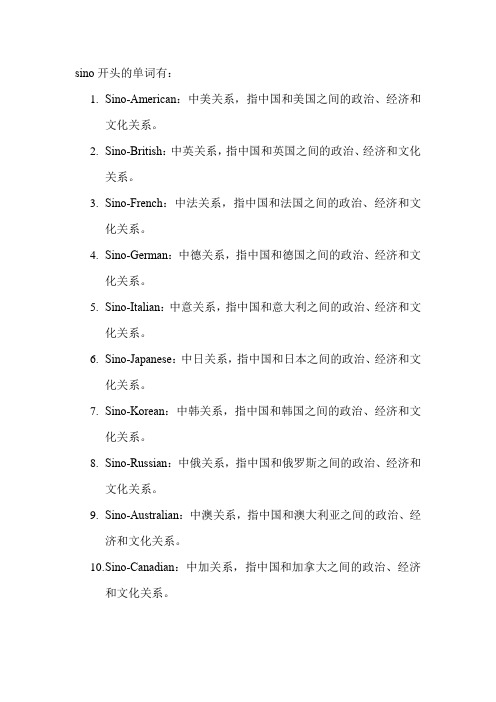
sino开头的单词有:
1.Sino-American:中美关系,指中国和美国之间的政治、经济和
文化关系。
2.Sino-British:中英关系,指中国和英国之间的政治、经济和文化
关系。
3.Sino-French:中法关系,指中国和法国之间的政治、经济和文
化关系。
4.Sino-German:中德关系,指中国和德国之间的政治、经济和文
化关系。
5.Sino-Italian:中意关系,指中国和意大利之间的政治、经济和文
化关系。
6.Sino-Japanese:中日关系,指中国和日本之间的政治、经济和文
化关系。
7.Sino-Korean:中韩关系,指中国和韩国之间的政治、经济和文
化关系。
8.Sino-Russian:中俄关系,指中国和俄罗斯之间的政治、经济和
文化关系。
9.Sino-Australian:中澳关系,指中国和澳大利亚之间的政治、经
济和文化关系。
10.S ino-Canadian:中加关系,指中国和加拿大之间的政治、经济
和文化关系。
中美外交关系专题词汇(英汉对照)
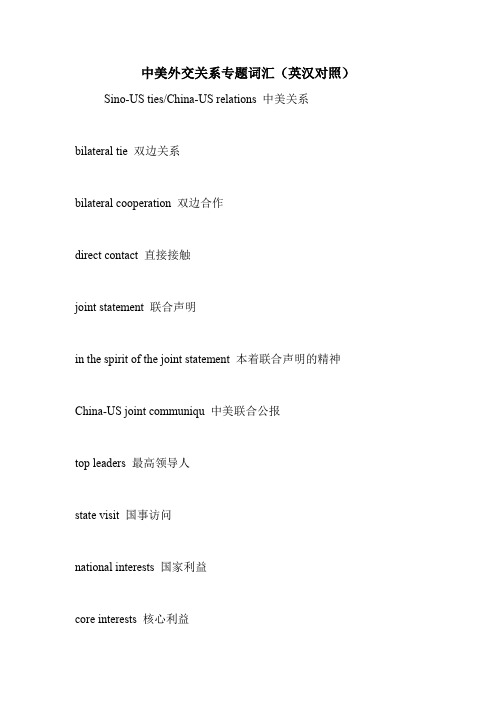
中美外交关系专题词汇(英汉对照)Sino-US ties/China-US relations 中美关系bilateral tie 双边关系bilateral cooperation 双边合作direct contact 直接接触joint statement 联合声明in the spirit of the joint statement 本着联合声明的精神China-US joint communiqu 中美联合公报top leaders 最高领导人state visit 国事访问national interests 国家利益core interests 核心利益common interests of the two countries 两国共同利益personality of the individual leaders 领导人的个人魅力frequent meetings 频繁会晤conflict-dominant relationship 冲突主导的关系the normalization of US-China relations 中美关系正常化start a new era in US-China relations 开创中美关系的新时代permanent consultative institutions 永久磋商机制constructive strategic partnership 建设性战略伙伴关系overall strategic partnership 全面战略伙伴关系rapprochement 恢复邦交Ping Pong diplomacy 乒乓外交high-level cooperation 高层协作Strategic and Economic Dialogue 战略经济对话establish diplomatic ties 建立邦交highly confidential visit 秘密访问zero-sum game 零和博弈mutual trust 相互信任common prosperity 共同繁荣peaceful coexistence 和平共处the situation on the Korean Peninsula 朝鲜半岛局势resumption of Six-Party Talks 重启六方会谈high-level visit 高层访问strategic suspicions 战略猜疑maintain a low profile 保持低姿态China will never seek hegemony. 中国永远不会称霸。
德国去中国邀请函模版[德国商务邀请函,德国商务邀请函模板]
![德国去中国邀请函模版[德国商务邀请函,德国商务邀请函模板]](https://img.taocdn.com/s3/m/d31b9b610a1c59eef8c75fbfc77da26925c59668.png)
德国去中国邀请函模版[德国商务邀请函,德国商务邀请函模板]德国商务邀请函模板(一)sehr geehrter herr / frau:vielen dank für ihr schreiben vom [datum].ich bin froh, dass du auch noch [hier] im nächsten monat.es wäre eine große freude, sie kennen zu lernen, auf die [ausstellung / messe).unsere firma ist ein empfang im [hotel] am abend [datum], und ich würde mich sehr freuen, wenn sie dabei sein können.ich freue mich, bald von ihnen zu hören.mit freundlichen grüßen,德国商务邀请函模板(二)sehr geehrter herr / frau:[unternehmen] hätte gerne jemanden aus ihrer firma sprechen auf unseren konferenz (thema).wie sie vielleicht wissen, die mission des vereins ist die förderung.viele unserer mitglieder daran interessiert sind, die leistungen ihres unternehmens aus.“unsere vorläufigen ablaufplan für die konferenz, die inwochen überprüft werden.ich rufe dich [datum] zu sehen, die von ihrer firma bereit wäre, zu uns zu sprechen.ich kann ihnen versichern, dass wir alles bequem auf den lautsprecher.mit freundlichen grüßen,德国商务邀请函模板(三)herr kleber bb / cc, pappel - kern, toleranz der dicke + / -0.5mm, m / c unter bb%, flachewenn du nicht versuchst, sie wird nie wissen, dass unsere qualität. sie erhöhen ihre konkurrenten absoluten vorteil, sie haben unsere gute qualität und bessere preise, wie kannst du mit ihnen konkurrierenwi r wollen wirklich schaffen, langfristige geschäftsbeziehung mit ihnen, so geben wir ihnen die besten preise. sie können im vergleich mit anderen anbietern jetzt. fragen sie ihre leute zur prüfung der qualität. verpassen sie nicht diese große chance. wenn s ie wollen, sagen sie mir sofort, weil die preise höher sein wird usdb auf 1b nach dem bbb - ich denke ihre aktuellen anbieter sind kleine fabriken, oder haben sie niedrigere preise mit niedriger qualität.ich glaube, sie haben nicht stabil und feste qu alität. wenn sie mehr aufträge, die sie nicht lhre befehle. ich bin gespannt auf ihreantwort.bbb - bitte machen sie ihre entscheidung so schnell wie möglich.wenn sie ihre wettbewerbsfähigkeit stärken wollen, zögern sie nicht, mich zu fragen, senden sie den kaufvertrag für sie.德国商务邀请函模板(四)sehr geehrter herr / frau:wir möchten sie einladen, einen exklusiven präsentation der neuen [waren].der vortrag findet um [ort], [mal] auf [datum].es wird auch einen empfang [mal].wir hoffen, dass sie und ihre kollegen können teilnehmen.[unternehmen] ist ein führender hersteller von hochwertiger qualität.wie sie wissen, die jüngsten technologischen fortschritte haben zunehmend erschwinglichen an die öffentlichkeit.unsere neuen modelle bieten hervorragend e qualität und eleganz mit wirtschaft und ihre neuen funktionen geben ihnen verschiedene vorteile auf vergleichbare produkte anderer hersteller.wir freuen uns, sie auf [datum].rufen sie unser büro an [telefon] und wir werden froh sein, einen sicheren ort für sie.mit freundlichen grüßen,德国商务邀请函模板(五)sehr geehrter herr / frau:ich freue mich sehr, dass sie unserer einladung gefolgt sind, zu sprechen, auf der konferenz in [[datum]] in der stadt.wie vereinbart, sie spricht über das t hema "" von [] [mal].es wird eine zusätzliche minuten für fragen.würden sie mir bitte sagen, was für audiovisuelle geräte brauchen sie.wenn du mich wissen lassen, ihre spezifischen anforderungen von [datum], ich habe viel zeit, dafür zu sorgen, dass das hotel bietet ihnen, was sie brauchen.nochmals vielen dank für die zustimmung zu sprechen.ich freue mich, von ihnen zu hören.mit freundlichen grüßen,。
German_
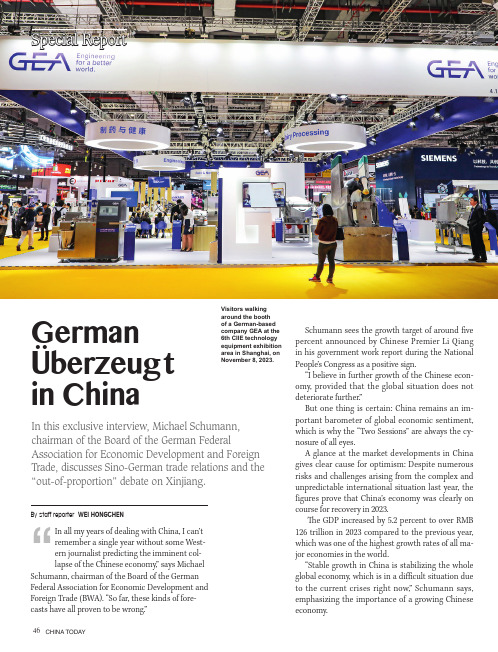
46CHINA TODAYSpecial Report“In all my years of dealing with China, I can’t remember a single year without some West-ern journalist predicting the imminent col-lapse of the Chinese economy,” says Michael Schumann, chairman of the Board of the German Federal Association for Economic Development and Foreign Trade (BWA). “So far, these kinds of fore-casts have all proven to be wrong.”By staff reporter WEI HONGCHENGerman Überzeugt in ChinaIn this exclusive interview, Michael Schumann, chairman of the Board of the German FederalAssociation for Economic Development and Foreign Trade, discusses Sino-German trade relations and the “out-of-proportion” debate on Xinjiang.Schumann sees the growth target of around five percent announced by Chinese Premier Li Qiang in his government work report during the National People’s Congress as a positive sign.“I believe in further growth of the Chinese econ-omy, provided that the global situation does not deteriorate further.”But one thing is certain: China remains an im-portant barometer of global economic sentiment, which is why the “Two Sessions” are always the cy-nosure of all eyes.A glance at the market developments in China gives clear cause for optimism: Despite numerous risks and challenges arising from the complex and unpredictable international situation last year, the figures prove that China’s economy was clearly on course for recovery in 2023.The GDP increased by 5.2 percent to over RMB 126 trillion in 2023 compared to the previous year, which was one of the highest growth rates of all ma-jor economies in the world.“Stable growth in China is stabilizing the whole global economy, which is in a difficult situation due to the current crises right now,” Schumann says, emphasizing the importance of a growing Chinese economy.Visitors walking around the booth of a German-based company GEA at the 6th CIIE technology equipment exhibition area in Shanghai, on November 8, 2023.47April 2024More Investment Than Ever BeforeAccording to the Federal Statistical Office of Germany, trade between China and Germany in 2023 crossed €253 billion, making China Germany’s largest trading partner for eight years in a row. Data from the German central bank showed direct investment from Germany in China reached a re-cord high of €11.9 billion last year – an increase of 4.3 percent compared to 2022. German companies made as many new investments in China between 2021 and 2023 as in the six years from 2015 to 2020. China attracted 10.3 percent of all German direct in-vestments abroad in 2023 – the highest figure since 2014. The data send out an important message: ties between the two major economies are still as close as ever, despite the global headwinds. China clearly remains an important investment destination for German companies.According to Schumann, German companies’ high investment volumes in China prove that the economic relations between the two countries still have a solid foundation. He attributes this especially to China’s positive business environment. One par-ticular attraction of the Chinese market is China’s innovation culture, he says. “The omnipresent digi-talization and China’s excellent infrastructure are two further crucial factors.” This mix has created attractive production conditions in China.“Apart from that, we in Germany have observed promising approaches to further opening up to the outside world from the Chinese side over the past year, which I hope will be expanded even more in the future,” he says. He gives the example of the suspen-sion of visa requirements for German citizens. “This has made things much easier for German companies doing business in and with China,” he says.In view of increasing global risks in the supply chains, more and more German companies in China are analyzing how to make their production sites in China more self-sufficient and better secure them, he said.For example, Volkswagen (China) has established its largest development center outside Germany in the city of Hefei in the central Chinese province of Anhui with an estimated total investment of €1 bil-lion. It covers the entire value chain for new energyvehicles, from research and development to production, sales, and services. The Sie-mens Group is also followingthis path. The Siemens R&D center for industrial softwarehas recently gone into op-eration in Shenzhen in south China.Since it was founded 21 years ago, the BWA has pro-vided targeted support for Chinese-German economic re-lations. Last year, the association recorded a signifi-cant surge in cooperation activities, particularly at company level and in municipal cooperation. From this, Schumann concludes that there is still great development potential for the German business community in China, especially in future-orientedareas such as environmental technology, biological Michael Schu-mann, chairman of the Board of the German Fe-deral Association for Economic Development and Foreign Trade.“What we need is more commitment, not less. Weneed cooperation insteadof confrontation, more exchange and understand-ing, despite living in dif-ferent political systems.”German Pavilionat the 24th ChinaInternational Opto-electronics Expo held in Shenzhen, onSeptember 6, 2023.48CHINA TODAYsciences, and life sciences.He rates the mood of German companies invest-ing in China as very positive. Companies are con-fident about China as a business location, which is borne out by the results of the latest Business Climate Survey 2023/24 conducted by the German Chamber of Commerce in China. The report says 54 percent of the 566 member companies surveyed plan to continue their investments in China.More Exchange and Understanding, Less RisksIn German politics, however, the current buzz-word is “de-risking.” The German government has called on domestic companies to reduce their de-pendency on China. Schumann thinks there should be a greater sense of proportion. Declaring a coun-try that has enjoyed such friendly relations with Germany for such a long time a “risk” across the board shows little knowledge of China and is the wrong approach, in Schumann’s opinion.In the slipstream of the de-risking discussion, a new debate has recently flared up in Germany about German companies investing in Xinjiang in north-west China. Schumann sees this as being drivenby some politicians and media. A few years ago, he went to Xinjiang and witnessed how economic in-vestments are improving the lives of the locals.“Those who are now questioning this commit-ment by foreign companies in Xinjiang would have to explain to me how the local people, whose wel-fare the critics claim to be concerned with, would be helped if the newly created job opportunities were taken away from them,” he says. “What we need is more commitment, not less. We need co-operation instead of confrontation, more exchange and understanding, despite living in different politi-cal systems.”Schumann thinks it is important to give German entrepreneurs a realistic picture of their opportu-nities in China. His advice to businesspeople is to familiarize themselves with the country first-hand. Unfortunately, this is currently being made difficult by the negative reporting in many Western media. However, there is something to be optimistic about: German Chancellor Olaf Scholz’s planned China visit in April. “I … hope the planned China visit by Chancellor Olaf Scholz accompanied by a German business delegation in mid-April will provide new positive impetus,” he concludes. CSpecial ReportCOOPERATION“We need coope-ration instead ofconfrontation, more exchange and un-derstanding, despiteliving in differentpolitical systems.”The R&D andproduction base of Volkswagen (An-hui) Automotive Company Limited in Hefei Economic and Technological Development Zone, on October 5, 2023.。
和有关英文短语精选合集
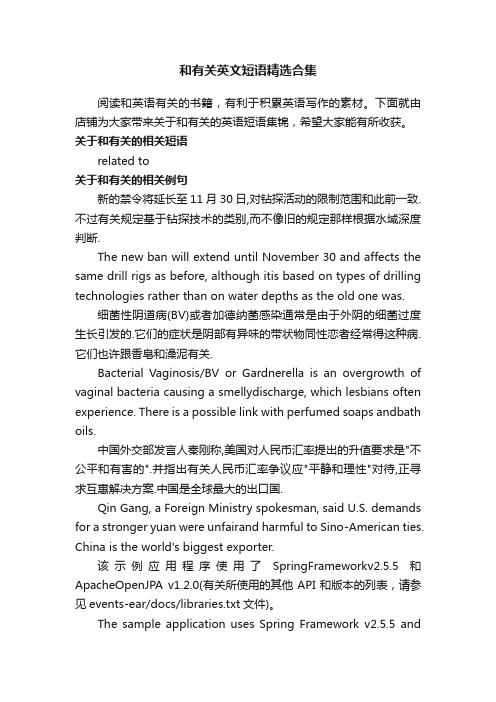
和有关英文短语精选合集阅读和英语有关的书籍,有利于积累英语写作的素材。
下面就由店铺为大家带来关于和有关的英语短语集锦,希望大家能有所收获。
关于和有关的相关短语related to关于和有关的相关例句新的禁令将延长至11月30日,对钻探活动的限制范围和此前一致.不过有关规定基于钻探技术的类别,而不像旧的规定那样根据水域深度判断.The new ban will extend until November 30 and affects the same drill rigs as before, although itis based on types of drilling technologies rather than on water depths as the old one was.细菌性阴道病(BV)或者加德纳菌感染通常是由于外阴的细菌过度生长引发的.它们的症状是阴部有异味的带状物同性恋者经常得这种病.它们也许跟香皂和澡泥有关.Bacterial Vaginosis/BV or Gardnerella is an overgrowth of vaginal bacteria causing a smellydischarge, which lesbians often experience. There is a possible link with perfumed soaps andbath oils.中国外交部发言人秦刚称,美国对人民币汇率提出的升值要求是"不公平和有害的".并指出有关人民币汇率争议应"平静和理性"对待,正寻求互惠解决方案.中国是全球最大的出口国.Qin Gang, a Foreign Ministry spokesman, said U.S. demands for a stronger yuan were unfairand harmful to Sino-American ties. China is the world's biggest exporter.该示例应用程序使用了SpringFrameworkv2.5.5和ApacheOpenJPA v1.2.0(有关所使用的其他API和版本的列表,请参见events-ear/docs/libraries.txt文件)。
18-语法总结
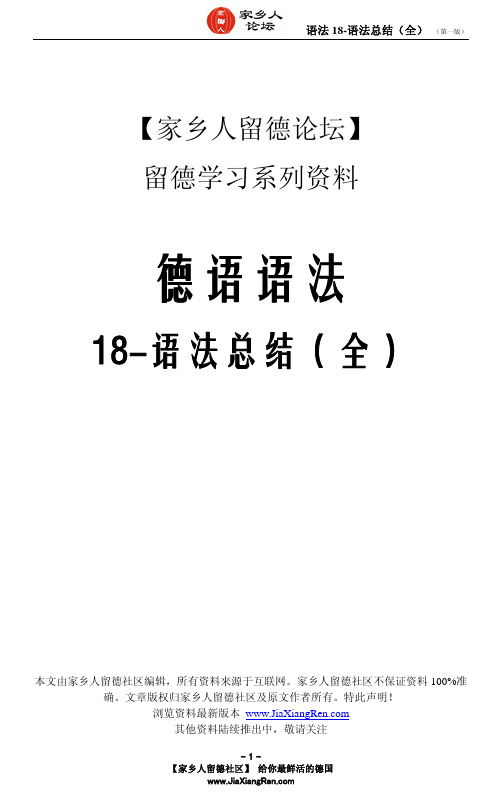
Deutschkurs der Bahnhof der Grüß der Anhalter der Nachmittag der Fahrer der Bodensee der Urlaubstag
Deutschkurse die Bahnhöfe die Grüße
den Biologen
dem Kollegen
den Kollegen
~ 形容词变化名词
der Deutsche
德国人
der Verwandte
亲戚
der Postbeamte
邮局职员
der Beamte
职员,公务员
der Junge
男孩
der Blinde
盲人
der Unbekannte
不熟悉的人
der Musiker der Mann
die Musiker die Männer
der Lebenslauf
der Name der Arbeiter
die Lebensläufe die Namen
die Arbeiter
火车站 问候,致意 拦车搭乘者 下午
司机,驾驶员 博登湖 休假日
Welcher Tisch ist schön? Der kleine Tisch ist schön. Welcher Tag ist heute? Heute ist Dienstag. ( 强 调 已 知 的 人 或 物 中 的 哪 一 个 ( 的 ), 哪 一 些 ( 的 )。 变 化 类 似 定 冠 词 , 第 二 格 阳 性 和 中 性 的
der Lesesaal
der Platz der Ausflug
- 1、下载文档前请自行甄别文档内容的完整性,平台不提供额外的编辑、内容补充、找答案等附加服务。
- 2、"仅部分预览"的文档,不可在线预览部分如存在完整性等问题,可反馈申请退款(可完整预览的文档不适用该条件!)。
- 3、如文档侵犯您的权益,请联系客服反馈,我们会尽快为您处理(人工客服工作时间:9:00-18:30)。
Extending Sino-German TiesON March 20,German President Joachim Gauck visited China at the invitation of China’s leader Xi Jinping. In recent years SinoGerman relations have burgeoned on all fronts,spearheading ties between China and Europe in general. How then to even further expand Sino-German relations in the new economic situation?And in which areas can the two countries further enlarge their cooperation in the process of China implementing its 13th Five-Year Plan and the Belt and Road Initiative?With these questions in mind,China Today interviewed China’s Ambassador to Germany,Shi Mingde.Sino-German Ties Prominent in Sino-EU TiesAs two of the world’s major economies,China and Germany have long maintained high-level,mutuallybeneficial cooperation. Mr. Shi lauded Sino-German relations as pivotal in the larger relationship between China and Europe,as attested by the frequent exchange of visits between their leaders.In 2014,for instance,Chinese President Xi Jinping embarked on an official visit to Germany,followed by Chinese Premier Li Keqiang ?C Li’s second since taking office. Followinghard on the heels of President Joachim Gauck in March,German Chancellor Angela Merkel will visit China this June,and then again in September for the G20 Summit. “These reciprocal visits by leaders of the two countries and mutual trust they instill pave a solid road for bilateral ties,”the ambassador said.Europe is the world’s largest cluster of developed countries,and the EU is the world’s largest inter-nation economic zone. The continent,therefore,occupies a critical position in the international political and economic landscape,and represents an important force in the world’smulti-polarization,Shi said.According to the ambassador,the relationship between China and Germany,a key component in that between China and Europe at large,has seen great momentum in its development. The two countries share a wide range of common interests,with well-established mutual trust,and no geopolitical conflicts or fundamental clashes of interest subsisting between them. Constantly advancing and deepening the China-EU comprehensive strategic partnership is consequently the desire of and in the interests of both parties.As Mr. Shi sees it,the Sino-German relationship is definedby its sound foundation,pragmatic cooperation and expansive prospects. “The Sino-German relationship is the pilot of the Sino-EU relationship. France and the U.K. have been playing catch-up in their relations with China,but have leapfrogged Germany in certain areas. Germany in turn is doing its part to catch-up here. This process creates a virtuous cycle that brings benefits to all parties involved,while offering incentives for European countries to develop their relations with China. This is a highlight in China’s diplomacy with other major countries.”Mr. Shi noted that,at a time when Europe faces a torrent of problems and China is undergoing economic restructuring,the two sides have tremendous scope for cooperation in diplomacy,economy,culture and peopleto-people exchanges.Last year,China and Germany celebrated their innovative partnership,and 2016 was designated a year for exchanges between their respective youth. More programs of cultural,economic and political cooperation were announced during President Joachim Gauck’s March visit.Deeper Economic and Trade CooperationEconomics and trade lie at the heart of Sino-German relations. Germany was the first Western power that launched across-the-board cooperation with China in the innovationsector,and it is China’s largest trade partner and leading source of imported technology and investment in Europe,while China is Germany’s No.1 trade partner outside of the EU.“Our trade with Germany accounts for 30 percent of our EU total. The figure exceeded US $160 billion last year,more than China’s trade with France,the U.K. and Italy combined. And this has been the trend for past years. There are 8,200 German companies operating in China,with their total investment exceeding US $40 billion,”the ambassador said. Meanwhile,more Chinese businesses are going to Germany. Thus far 2,000-odd have invested there,and corporate mergers are on the rise. New areas of bilateral cooperation have also been tapped.“The two governments have reached a deal for strategic cooperation between Germanys’Industry 4.0 and Made in China 2025,as well as production capacity cooperation in a third country,”Mr. Shi added.Germany was among the first to pledge support for China’s Belt and Road Initiative,and to join the Asian Infrastructure Investment Bank (AIIB). Its contribution to the bank is also among the highest. Great potential thus beckons for the two countries’cooperation under the Belt and Road Initiativeframework. According to Mr. Shi,the two countries are negotiating on new cooperative fields,including cooperation in a third country and cooperation on infrastructure,which is expected to be included in pacts signed during Chancellor Angela Merkel’s visit to China this June.Germany forms the terminus for Sino-Europe block trains from 10 Chinese cities. Furthermore,China and Germany are the two largest economies along the rail routes of the Belt and Road Initiative. This fact necessitates closer cooperation between them. China Railway Group,Ltd. and Deutsche Bahn are now in talks seeking better coordination to facilitate customs clearance,but this will also entail additional responsive measures by other countries along the Belt and Road. Team-up between Two Manufacturing Powers Germany’s Industry 4.0 sets a model for global industrialization,and exerts a tremendous impact on the world’s manufacturing industry. During Angela Merkel’s 2015 visit to China,the two countries resolved to harmonize the German program with Made in China 2025. For this purpose,a vice-ministerial-level work mechanism was established between Germany’s Federal Ministry for Economic Affairs and Energy and China’s Ministry of Industry and InformationTechnology. The two sides are now in discussions regarding key cooperative fields,which will soon yield tangible results. Mr. Shi noted that possible sectors of cooperation include manufacturing,electric automobiles,environmental protection and energy saving,all areas of interest to companies in both countries.He stressed that room remains for further expansion of bilateral cooperation. Germany has particular strength in some of the priority areas listed in China’s 13th FiveYear Plan and Made in China 2025,such as environmental protection,energy conservation and cooperation in a third country. “China and Germany are two of the world’s largest manufacturers. Germany,however,sits at the higher end,with China occupying the middle and lower reaches of the industrial chain. This disparity opens up a huge space for cooperation,”Mr. Shi said.China’s great growth potential and huge market appeal to Germany. Its three largest automakers would not have seen such recent sustained growth without the Chinese market. For instance,one third of Volkswagen’s global production comes from China.According to the ambassador, a priority for cooperationbetween Chinese and German auto industries is to develop electric cars. “China plans to produce two million electric cars annually by 2020. China and Germany can complement each other on technological issues,as they have their respective strengths in this regard. The team-up between the two powers will hopefully place them in the leading position in the electric automotive secto r globally.”When asked how to stave off discord and seek common ground in bilateral ties,Mr. Shi admitted that theSino-European economic relationship has hitherto been riddled with disputes,but the two sides have devised multiple dialogue mechanisms to resolve these.“We appropriately resolved the dispute over China’s photovoltaic exports to Europe. Such conflicts are inevitable given the two sides’different social systems and levels of economic development. Via engaging in dialogues posited on equality and striking a balance that serves both sides’interests we can settle any problems that may arise,”he concluded.。
